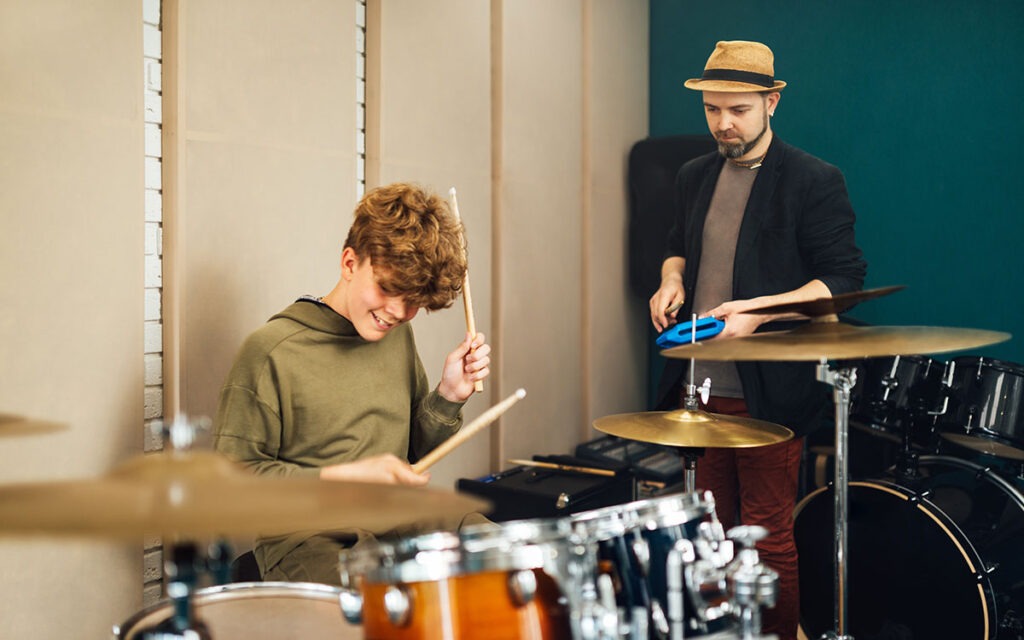Best Drum Lessons for All Skill Levels: Beginner to Pro
Best Drum Lessons for All Skill Levels: Beginner to ProReady to learn drums or take your drumming to the next level? This guide on drum lessons will help you start, improve, and master drumming. Find tips, resources, and structured lessons for every skill level, whether you’re a beginner or an experienced drummer.
Key Takeaways
Drum lessons cater to all skill levels, from beginner basics like rhythm and first beats to advanced techniques such as soloing and complex patterns.
Effective practice is essential for improvement, with tools like metronomes and structured goals helping drummers enhance their skills consistently.
Online resources and communities provide flexible learning opportunities, while private lessons offer personalized guidance to help drummers achieve their specific goals.
Beginner Drum Lessons

Every drummer starts their journey somewhere, and taking your first steps can be both thrilling and overwhelming. Beginner drum lessons are designed to ease new drummers into the world of rhythm and percussion.
These lessons lay the foundation by focusing on essential skills such as understanding rhythm and tempo, learning your first drum beat, and getting acquainted with basic equipment. A structured approach helps new drummers build confidence and develop a solid foundation.
Understanding Rhythm and Tempo
Understanding rhythm and tempo is crucial for any drummer. Rhythm ensures consistent and even playing, which is vital for maintaining the music’s flow. Drummers often count to four to divide the tempo into manageable groups, creating a clear structure for the music. Counting the tempo out loud before starting a song helps maintain a consistent pace. This practice helps keep the rhythm steady and ensures all band members stay in sync.
Playing music while marking the beats on your drums solidifies your role within the context of tempo. One basic technique involves counting the eighth notes out loud, such as ‘1 and 2 and 3 and 4 and’. This method helps new drummers internalize the rhythm, making it easier to stay consistent.
With a solid understanding of rhythm and tempo, you’ll be well-equipped to tackle more complex patterns and exciting drum fills.
First Drum Beat
The first drum beat you learn sets the stage for your drumming journey. A popular beat for beginners is the basic pattern used in ‘We Will Rock You,’ which consists of bass bass clap. This simple yet iconic beat introduces new drummers to the concept of rhythm without overwhelming them.
Another fundamental pattern is the single stroke, where the snare drum is played on beats 2 and 4 while maintaining the hi-hat with the right hand. Starting with these basic patterns allows you to get comfortable with the drum kit and develop your timing.
As you practice, you’ll find that your coordination improves, and you’ll be ready to explore more complex beats. Remember, every great drummer started with these simple steps, and with consistent practice, you’ll be able to play the drums with confidence.
Basic Equipment for Beginners
Before you start learning drums, having the right equipment is essential. A good-quality practice pad and drumsticks are crucial for beginners. Practice pads offer a quieter way to develop your technique before progressing to a full drum kit.
It’s recommended to start with a 5-piece starter drum kit, which includes all the necessary components for learning. With these tools, you’ll be well-prepared to dive into your drumming lessons and start mastering the basics.
Intermediate Drum Lessons

As you move beyond the basics, intermediate drum lessons focus on enhancing your rhythm complexity and developing coordination skills. These lessons introduce more intricate drum fills and coordination exercises, which are crucial for improving overall technique and musicality.
Intermediate drummers also benefit from practicing popular songs, allowing them to apply their skills in a musical context and collaborate with fellow musicians.
Developing Drum Fills
Drum fills are variations at the end of a section that create excitement and add flair to your playing. A basic drum fill for beginners might include an open hi-hat followed by a quick snare drum after three repetitions of a basic beat. Another useful fill is the paradiddle, which consists of two single strokes followed by two double strokes and comprises eight notes. This pattern can be applied in various ways to enhance your regular drum beats and make your playing more dynamic.
Jared Falk offers a video series on developing drum fills, which can be a helpful resource for intermediate drummers. Practicing these fills expands your drumming vocabulary and teaches you how to incorporate exciting drum fills into your playing. This not only improves your technical skills but also makes your drumming more engaging and fun.
Coordination Exercises
Coordination exercises are essential for intermediate drummers as they improve hand and foot coordination, which is crucial for more complex drumming patterns. Effective exercises often combine hand and foot patterns to build proficiency, helping you play more intricate rhythms with ease.
Regularly practicing coordination exercises enhances your overall technique and prepares you for advanced drumming challenges.
Popular Songs to Practice
Practicing popular songs is a great way to improve your drumming skills and learn different styles. In as little as five minutes, you can start playing your first song, which boosts your confidence and keeps you motivated. Some excellent songs for intermediate practice include tracks with intermediate-level drum parts, which help you develop your timing, coordination, and adaptability.
Drum fills increase your drumming vocabulary and teach related techniques. By incorporating fills into your practice, you’ll not only improve your technical skills but also gain a deeper understanding of different musical styles. This holistic approach to practice ensures that you grow as a well-rounded drummer, ready to tackle more advanced challenges.
Advanced Drum Lessons
Advanced drum lessons are designed to challenge seasoned drummers and push their skills to the next level. These lessons focus on practicing advanced intermediary grooves, shifts, and meters. Drummers also explore complex time signatures and soloing techniques, which require a high level of precision and creativity.
With consistent practice and dedication, advanced drummers can achieve greater musicality and expression in their playing.
Advanced Rudiments
Drum rudiments are essential patterns in drumming that form the foundation for more complex techniques. Advanced drum rudiments enhance speed, control, and overall musicality. The Moeller Technique, for example, allows drummers to achieve speed and power by using arm weight and proper hand movements. Control over rebound and strokes is crucial for executing these rudiments effectively.
Mastering advanced drum rudiments leads to greater versatility and expression in drumming. Incorporating these patterns into your practice routine allows you to tackle more challenging pieces and develop a unique drumming style. Advanced rudiments are a key component of any serious drummer’s toolkit, helping you achieve technical excellence and creative freedom.
Complex Time Signatures
Complex time signatures are an exciting challenge for advanced drummers. These rhythms go beyond the standard 4/4 and require a deep understanding of timing and coordination. Practicing complex time signatures helps drummers develop their sense of timing and adaptability, which are critical for playing intricate pieces.
Mastering these rhythms adds a new dimension to your drumming and impresses audiences with your technical prowess.
Soloing Techniques
Soloing in drumming allows you to express your musical ideas and skills spontaneously. Drummer Antonio Sanchez is known for his innovative soloing techniques, which can serve as inspiration for advanced drummers. Practicing improvisation and experimenting with different rhythms helps develop unique soloing styles that set your performance apart.
Creativity in drum solos can engage listeners and make your performance more memorable. Incorporating diverse techniques and rhythms into your solos captivates your audience and showcases your drumming skills.
Soloing is a powerful tool for self-expression and musical exploration, making it an essential skill for advanced drummers.
Practicing Drums Effectively

Effective practice is the cornerstone of becoming a great drummer. Applying structured routines and setting clear goals can significantly enhance your progress. Incorporating tools like metronomes and creating balanced practice schedules allows you to focus on various aspects of drumming, from technique to musicality.
Let’s explore some key strategies to make your practice sessions more productive.
Using a Metronome
A metronome is an invaluable tool for maintaining timing and consistency in your drumming practice. Beginners can start by setting the metronome to a specific BPM and playing notes on each click to develop steady timing.
For a more advanced challenge, try playing two notes for every beat, which improves precision and coordination. Using a metronome regularly will help you stay on beat and enhance your overall drumming skills.
Setting Practice Goals
Setting clear practice goals is essential for focused and effective learning. Applying the S.M.A.R.T framework—Specific, Measurable, Attainable, Realistic, and Time-sensitive—can guide you in creating effective practice goals. For example, you might set a goal to learn a specific drum fill within a week or to improve your timing by practicing with a metronome daily.
Ranking your goals by difficulty can help you allocate time and focus effectively during practice sessions. Writing down your goals increases accountability and provides a clearer pathway for achieving drumming proficiency.
By balancing technical skill practice with musicality, you’ll enhance your overall drumming ability and make your practice sessions more enjoyable.
Creating a Practice Schedule
Creating a balanced practice schedule is essential for comprehensive development as a drummer. Your schedule should incorporate various aspects, including technique, rhythm, coordination, and creativity. Allocating time for both technical skills and musicality ensures well-rounded growth.
By following a structured routine, you’ll make steady progress and stay motivated throughout your drumming journey.
Private Drum Lessons
Private drum lessons at Sandy Music Academy offer personalized guidance and tailored instruction that matches your individual learning pace and style. With a customized curriculum, you can focus on your preferred music genres and styles while receiving immediate feedback to correct mistakes and improve your technique quickly.
Let’s delve into how to find the right instructor, prepare for lessons, and track your progress effectively.
Finding the Right Instructor
Finding the right drum instructor starts with identifying your personal learning goals, such as specific techniques you wish to master or styles you want to explore. Consider the experience, teaching style, and approach of potential instructors to find someone whose methods align with your preferences. At Sandy Music Academy, we have drum teachers who use various techniques and teaching styles to suit almost every drummer’s needs.
Regular feedback and tracking your progress with your instructor will ensure you develop the skills needed to achieve your drumming goals.
Preparing for Lessons
Preparing for private drum lessons involves setting specific goals and reviewing materials beforehand. A fun, supportive, and comfortable atmosphere enhances learning, especially for children. Understanding studio etiquette and collaboration can also improve the quality of recorded drum tracks.
Being well-prepared helps you make the most of each lesson and accelerates your progress.
Feedback and Progress Tracking
Personalized feedback from private drum lessons is crucial for identifying strengths and areas for improvement. Finding the right instructor can enhance the learning experience and facilitate effective progress tracking.
Setting measurable practice goals and regularly reviewing your progress with your instructor ensures consistent growth and helps you stay on track to achieve your drumming goals.
Playing in a Band

Playing in a band is an exhilarating experience that allows drum students to develop their musicality and collaboration skills. The drummer is the beating heart that keeps the music alive, and performing in live shows helps students progress to intermediate and advanced levels.
Let’s explore the dynamics of working with other musicians, preparing for live performances, and recording sessions.
Working with Other Musicians
Playing in a band setting allows drummers to enhance their musicality by listening and responding to other musicians. Consistent communication among band members ensures that everyone is aligned rhythmically and contributes to a cohesive sound. Working together on dynamics and tempo during rehearsals strengthens the rhythmic foundation and improves overall performance quality.
Preparing for live performances requires integrated practice to create a cohesive sound that showcases each musician’s talents. Understanding the basics of recording sessions ensures that drummers support the overall musical vision while capturing their rhythm effectively. Collaboration and cohesive playing are key to improving performance quality within a band.
Live Performances
Live performances are the ultimate test of a drummer’s skills and stamina. A reliable metronome is essential for maintaining tempo and establishing the groove during live shows. Drummers should practice active listening and observation to enhance their performance and coordination with other musicians. Using cue sheets can help remember song arrangements and maintain focus during performances.
Physical fitness plays a significant role in a drummer’s performance quality during live shows. Setting up your drum kit properly facilitates smoother performances and improves overall fluidity while playing live. Thorough preparation and fitness ensure you can deliver outstanding live performances that captivate your audience.
Recording Sessions
Recording sessions require meticulous preparation to ensure high-quality drum tracks. Before starting a recording session, ensure your drum set is properly tuned and in good condition. Setting up the room for optimal acoustics and using high-quality microphones placed correctly around the drum kit can significantly affect the quality of your recordings.
Recording each drum piece separately provides more control in the mixing process, enhancing the precision and overall sound of your tracks.
Understanding Drum Sheet Music and Tabs
Understanding how to read drum sheet music and tabs is an essential skill for drummers. Drum sheet music provides crucial information about which drums to play, when to play them, and their duration.
Drum tablature, on the other hand, is a simplified notation method that visually represents drum patterns without traditional notes. Mastering both notations allows you to create and play new beats effectively.
Reading Drum Sheet Music
Reading drum sheet music involves understanding various symbols and their meanings. A rest represents a quiet space when a note is not played, while the bass drum note typically starts on Beat 1 and is associated with one beat, known as a crotchet. Short notes played on the hi-hat are called quavers. Dynamic symbols in drum music guide the player on the intensity of each note.
Learning to read drum sheet music can significantly enhance your drumming skills and allow you to play more complex pieces accurately. Familiarizing yourself with these symbols and practicing regularly will enable you to read and interpret drum sheet music with ease, opening up a world of musical possibilities.
Writing Your Own Beats
Writing your own drum beats is a creative process that allows you to express your unique musical style. A basic pattern typically includes the bass on beats 1 and 3 and the snare on beats 2 and 4. To create your own beats, you can rearrange bass and snare patterns to suit your musical preferences. Experimenting with different patterns and rhythms can lead to the development of exciting and original drum fills.
By mastering the art of writing your own beats, you’ll enhance your creativity and versatility as a drummer. This skill not only allows you to contribute original content to your band but also helps you understand the intricacies of drumming on a deeper level.
Summary
From the basics of rhythm and tempo to the complexities of advanced drumming techniques, this guide has covered the essential elements needed to master the drums at any skill level. Whether you’re just starting or looking to refine your skills, structured lessons, effective practice routines, and the right resources are key to your success. Embrace the journey, stay dedicated, and let your passion for drumming drive you to new heights.
Frequently Asked Questions
How do I start learning drums as a beginner?
To start learning drums as a beginner, focus on understanding rhythm and tempo first, then practice basic drum beats. Make sure to get essential equipment like a practice pad and drumsticks to kick off your journey!
What are some good songs for intermediate drummers to practice?
A great choice for intermediate drummers is “Seven Nation Army” by The White Stripes, as it features catchy, steady beats. You can also try “Boulevard of Broken Dreams” by Green Day for its dynamic fills and varied rhythms.
How can I improve my drumming coordination?
To improve your drumming coordination, practice exercises that mix hand and foot patterns regularly. This will help you build proficiency and enhance your overall rhythm skills.
What are the benefits of private drum lessons?
Private drum lessons provide you with personalized guidance and tailored instruction, allowing you to progress more efficiently with immediate feedback. You’ll really feel the difference in your playing!
How can I create my own drum beats?
To create your own drum beats, rearrange basic bass and snare patterns in a way that suits your style, and don’t hesitate to experiment with different rhythms to make them your own. You’ll find that mixing things up can lead to some exciting sounds!
